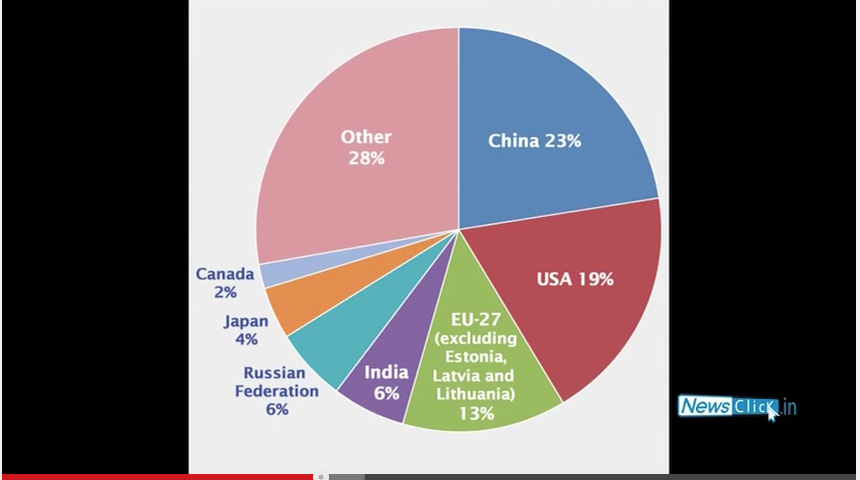US-China Agreement on Climate Change: Far Below What We Require - Part 1
Newsclick interviewed D. Raghunandan of All India People's Science Network on the recent US-China deal on carbon emissions. USA has agreed to reduce its emission by 26-28% by 2030 and 80% by 2050 with 2005 as the base year. China has agreed to 2030 as the peaking year and increasing the share of non fossil fuel consumption to 30% by 2030. Raghunandan believes that while it may appear to break the log-jam of the climate change negotiations, it is well below what a science based approach requires. The combined emissions of the US and China is more than 40% of the total global emissions. The US proposal in its ambition is far below than the IPCC Proposed 40% reduction in emission by 2020 and European Union’s commitment to reduce it by 30% till 2030 using 1990 as a base and not 2005 as the US has committed to. This agreement by the US and China will not help limit the global rise in temperature below 2 degree Centigrade, which is the red-line for climate change.

Rough Transcript:
Prabir Purkayastha (PP)- Hello and welcome to Newsclick. Today we have with us D. Raghunandan, President of the All India Peoples Science Network (AIPSN) and a former member of the Government's Low Carbon Path to Development. Raghu, we recently have this agreement between China and the US which seems to wipe off the climate change in larger negotiations. They seem to have each agreed to something which is comfortable to both China will still expand their per capita editions to something like 10 tonnes per head, and the US is proposing to come down to 15-16 tonnes per head by 2030. Do you think this is a bad omen for the climate change negotiations or do you think it's a part of a larger settlement which is emerging from below as was the US attempt to steer in Copenhagen?
D. Raghunandan (DR)- I think it's a bit of both. In the first place, I think, one should say that in the present circumstances, any move forward compared to the quagmire that the negotiations are stuck in, I suppose one should say it's a good thing. The US has increased its emissions commitment from the Waxman-Markey standard of 17% below 2005 to 26-28% below 2005. And China has, for the first time, accepted a peaking year, which as you will recall, it fought very hard against at Copenhagen and refused to do so. Having said that, it's very clear that the actual commitments, if you look at them quantitatively,are far below what the requirement would be, if you are looking at the 2 degree centigrade goal. The US and China put together today represent more than 40% of current emission flows, and clearly unless there are very major contributions by these two countries, you are not going to be able to reach the agreement that we want in order to reach the 2 degrees goal. The US, of course, it's 26-28% really amounts to only 13%, if you take 1990 as the base line year, whereas, they have taken 2005 as the base line year. And this is, of course, shamefully below the 40% reduction by 2020, which IPCC has called for, by developed countries and is also very far below the European Union's commitment of 30% reduction below 1990 levels. So the US is clearly not doing the world any great favour.
Prabir Purkayastha(PP)- So they said interesting argument which Obama cannot gave that anyway if the shift by fracking to natural gas, wind, which they are also implementing, which is reasonably cheap, the emissions are going to come down, so what he cannot tell the republicans, "I am actually fooling rest of the world by taking commitment which you are gonna do in any case??
D. Raghunandan(DR)- Right, exactly! Ironically, the Chinese commitment now, of capping their emissions by 2030, while it is, in a sense, dramatic, it's a new announcement and the China US joint announcement seems to have triggered a lot of excitement in the media and in several other countries, saying this is now going to put pressure on others to raise their levels of ambition. Studies within China, by climate think tanks, by government agencies, by the Chinese Academy of Social Sciences, have earlier predicted that China on a business as usual trajectory, will peak between 2030-2035 anyway. So, China is also, in a sense, making a virtue out of necessity which it is going to, and unfortunately, it's not informed the world what its peak level is going to be at 2030, if they were slowing down their emission's trajectory drastically and would reach a very low level in 2030, that would have been something. They've also not declared, whether and if they will start declining and when they will start declining and to what level they will decline after 2030. So that's all so, up in the air, at the moment. The other announcement by China which has attracted a lot of attention, is their announced goal of reaching 30% energy production from non fossil sources again by 2030. You may remember that China has already, on the table, has announced policy of reaching 20% non-fossil by 2020. So, another 10% in the next 5 years is not such a great achievement. So, in a sense, quantitatively, I don't see this announcement as being very significant for the world.
Prabir Purkayastha (PP)- This is the first part of our discussion with D. Raghunandan on climate change and the US and China Agreement. We'll come back on this for the next part.
Get the latest reports & analysis with people's perspective on Protests, movements & deep analytical videos, discussions of the current affairs in your Telegram app. Subscribe to NewsClick's Telegram channel & get Real-Time updates on stories, as they get published on our website.
























